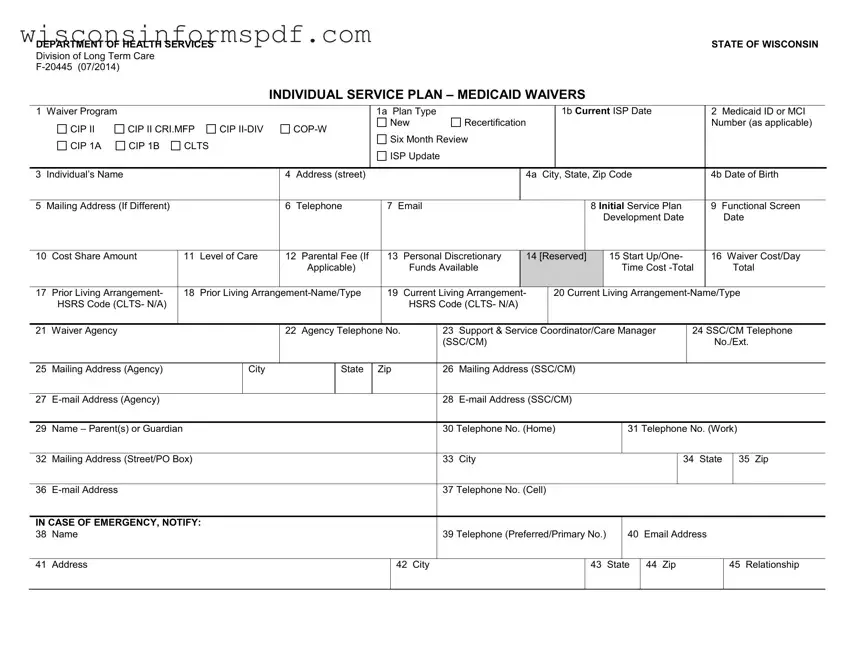The Individual Education Plan (IEP) closely resembles the Individual Service Plan in Wisconsin, particularly in its personalized approach to addressing specific needs. Like the ISP, IEPs are meticulously designed to outline the educational objectives and services for students with disabilities, ensuring tailored support within the educational system. Both documents share a collaborative nature, involving a team of professionals and family members to develop and periodically review the plan to align with the individual's evolving needs. This ensures services are precisely targeted to promote the individual's growth, further emphasizing a person-centered planning approach.
Another document that shows considerable similarity to the Individual Service Plan is the Person-Centered Plan (PCP) used in various health and social services settings. The PCP focuses on the preferences, goals, and strengths of individuals receiving services, such as those with mental health challenges or developmental disabilities. Both plans emphasize active participation of the individual in the planning process, ensuring that the services provided not only meet their needs but also align with their personal values and life goals, thereby fostering greater satisfaction and outcomes in the services received.
The Advanced Healthcare Directive, although primarily a legal document, shares fundamental elements with the Individual Service Service Plan by allowing individuals to outline their preferences and requirements for healthcare interventions. In scenarios where individuals might not be able to make decisions for themselves, both documents serve critical roles in guiding healthcare providers and caregivers to respect and follow the individual’s wishes, ensuring that the services and interventions are closely aligned with their preferences and needs.
The Treatment Plan used in behavioral health settings also mirrors elements of the Individual Service Plan. Designed for individuals undergoing therapy or psychiatric care, the Treatment Plan outlines specific goals, interventions, and metrics for success, oriented towards the individual's recovery and wellbeing. Much like the ISP, it is developed collaboratively by a team of professionals in consultation with the patient, ensuring a tailored approach to address their unique mental health needs with evidence-based interventions.
The Care Plan in nursing and long-term care parallels the ISP, focusing on the elderly or individuals with chronic conditions. It outlines the medical, physical, and emotional support services that will be provided to meet the specific needs of the person. Both plans are dynamic, requiring regular updates to reflect the changing needs of the individual. The collaborative nature of Care Plans ensures that healthcare professionals, caregivers, and the individual (and sometimes their families) are all involved in the planning process, just like with ISPs.
The Independent Living Plan (ILP) shares a similar objective with the Individual Service Plan by aiming to enhance the autonomy and self-sufficiency of its beneficiaries, such as youth transitioning out of foster care. ILPs lay out career, educational, and financial goals, among others, with a clear set of steps and resources to achieve these targets. Both plans are personalized, emphasizing the empowerment of individuals through tailored support services to navigate their lives independently and successfully.
The Service Coordination Plan, used within various social service programs, aligns closely with the ISP by coordinating and documenting the range of services required by an individual or family. This plan ensures that all providers are informed and working collaboratively towards the individual's overarching goals across different service sectors, emphasizing a holistic approach to support similar to that of the ISP.
The Support Plan, especially in the context of developmental or intellectual disabilities, also compares closely to the Individual Service Plan. It details the support measures necessary for individuals to live as independently as possible, including daily living activities, community inclusion, and personal development. Both plans are instrumental in highlighting the services and interventions that work best for the individual, reinforcing the importance of a customized approach to support and care.





 I have been informed that I have a
I have been informed that I have a 
 I have been informed of my
I have been informed of my 
 I understand that I have CHOICES in the waiver programs, including my right to CHOOSE from available, qualified providers that will provide the services outlined in my plan.
I understand that I have CHOICES in the waiver programs, including my right to CHOOSE from available, qualified providers that will provide the services outlined in my plan.
 I have been informed verbally and in writing of my rights and responsibilities in the Medicaid Waiver Programs and I understand these rights and responsibilities.
I have been informed verbally and in writing of my rights and responsibilities in the Medicaid Waiver Programs and I understand these rights and responsibilities.
 I have been informed verbally and in writing of my
I have been informed verbally and in writing of my 
 I have been informed verbally and in writing of my
I have been informed verbally and in writing of my 
 By
By 
 The SIX MONTH ISP Review was completed with the participant/guardian on the date below and there are no changes to the ISP at this time.
The SIX MONTH ISP Review was completed with the participant/guardian on the date below and there are no changes to the ISP at this time.
 The SIX MONTH ISP Review was completed with the participant/guardian on the date below and agreed upon changes to the ISP are included herein.
The SIX MONTH ISP Review was completed with the participant/guardian on the date below and agreed upon changes to the ISP are included herein.
 The ISP was UPDATED on the date below to reflect changes (additions, increases or reductions) to planned services or providers or to units/frequency of service.
The ISP was UPDATED on the date below to reflect changes (additions, increases or reductions) to planned services or providers or to units/frequency of service.

 A variance to the
A variance to the 
 A variance to allow waiver funding for an individual that is elderly to reside in a CBRF connected to a nursing home
A variance to allow waiver funding for an individual that is elderly to reside in a CBRF connected to a nursing home